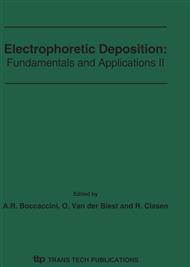p.213
p.219
p.225
p.231
p.237
p.245
p.251
p.257
p.263
Electrophoresis in Membrane Separation Processes: From Lab to Field Scale Experiments
Abstract:
In this paper results of electrophoretically activated processes for domestic wastewater treatment in lab and field scale experiments are presented. The principal mechanisms of non-membrane and membrane based electrokinetic solid liquid separation by electrophoresis are described. In the case of non-membrane based electrokinetic wastewater treatment a modular processing scheme is suggested in order to achieve economically and ecologically suitable processing conditions based on colloidal wastewater characteristics. In the case of membrane based electrokinetic waste water treatment an effective anti-membrane fouling process is designed controlled by colloidal characteristics of the wastewater, especially zetapotential, as well as external field parameters and microfiltration module geometries. The specific energy input of the membrane based and non-membrane based electrophoretic waste water treatment methodologies are compared and future perspectives of electrokinetic activated waste water purification processes are proposed.
Info:
Periodical:
Pages:
257-262
Citation:
Online since:
July 2006
Authors:
Price:
Сopyright:
© 2006 Trans Tech Publications Ltd. All Rights Reserved
Share:
Citation:


